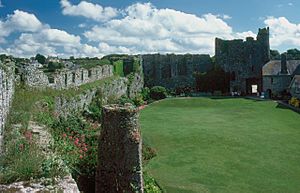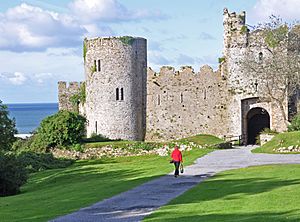Manorbier Castle facts for kids
Quick facts for kids Manorbier Castle |
|
|---|---|
| Part of Pembrokeshire | |
| Manorbier, Wales | |

The castle stands right on the coast just above the beach.
|
|

The inner ward of the castle.
|
|
| Coordinates | 51°38′44″N 4°47′59″W / 51.6455°N 4.7998°W |
| Type | Norman Rectangular castle |
| Height | Up to 16 metres (52 ft) |
| Site information | |
| Owner | Private |
| Open to the public |
Yes |
| Condition | Partially restored |
| Site history | |
| Built | 12th Century |
| Built by | William de Barri |
| Materials | Limestone |
|
Listed Building – Grade I
|
|
Manorbier Castle (which is called Castell Maenorbŷr in Welsh) is an old Norman castle. You can find it in Manorbier, about 5 miles (8 km) southwest of Tenby, Wales. The de Barry family, who were Anglo-Normans, started building it in the late 1000s. This castle was part of a smaller area ruled by a local lord, under the main control of the Earl of Pembroke during the Middle Ages.
Contents
Building the Castle
Manorbier is a rectangular castle. It has strong curtain walls and both round and square towers. The castle sits on a natural piece of land sticking out into the sea. This means it didn't need a moat (a ditch filled with water) around its outside.
The main way into the castle's inner ward (the main courtyard) was through a tower gateway. This gate was well protected. It had a portcullis (a heavy metal or wooden gate that slides down). It also had openings in the roof for dropping things on attackers. A very strong iron and wood door kept people out. There was also a smaller, secret gate called a postern gate. This gate led down to the beach and the sea.
The tower on the southeast side is round, while the one on the northeast is angular (has sharp corners). The castle also had living areas, like kitchens and apartments. It had a large Great hall for gatherings. These parts were finished around the 1140s. Over time, windows were added to these living areas. These windows replaced the narrow arrowslits that soldiers used to shoot arrows from. A special chapel was built around 1260. It had fancy arched ceilings and plaster decorations. Some of the original paintings from the Middle Ages can still be seen there.
Outside the main castle, there were earthworks (mounds of earth). These helped to create an outer ward (another courtyard). There was no barbican, which is a fortified gatehouse. A bridge crossed a ditch to connect the inner and outer wards.
Castle History
The land for Manorbier Castle was given to Odo de Barri. He was a Norman knight who received it at the end of the 1000s. At first, he built a motte-and-bailey castle here. This was a simple castle with a wooden keep (tower) on a mound of earth. It was protected by a wooden fence called a palisade and earth banks.
Later, in the early 1100s, Odo's son, William de Barri, made the castle much stronger. He used Limestone from local quarries to build stone walls and towers.
A famous person named Gerald of Wales was born at the castle in 1146. He was a great scholar from the 12th century. People knew him as Geraldus Cambrensis. He was the youngest of William de Barri's four sons. His mother's family was related to the legendary Welsh princess Nest ferch Rhys. Gerald loved his birthplace very much. He wrote:
"In all the broad lands of Wales, Manorbier is the most pleasant place by far."
Manorbier Castle was only attacked twice in its long history. Both times were small fights. In 1327, Richard de Barri attacked the castle. This was part of a disagreement over who should inherit the family's property. Then, about 300 years later, during the English Civil War, Parliamentarian forces took over the castle in 1645. After they captured it, they deliberately damaged it. This was done to stop the Royalists (who supported the King) from using it again for military purposes.
During the 1600s and 1700s, Manorbier Castle slowly fell apart. But in 1880, a person named J.R. Cobb, who was renting the castle, started to fix it up. He repaired the buildings and walls, bringing some of its glory back.
Manorbier Castle Today
The castle is still privately owned today. It is open for people to visit. You can explore the castle itself, its gardens, the old dovecote (a building for doves), and the mill. The castle is also a popular place for weddings. Part of the castle has even been turned into a holiday home where people can stay.
Media Appearances
Manorbier Castle has been used in several movies and TV shows.
- The BBC used the castle as Cair Paravel and The White Witch Castle. This was for their TV series The Chronicles of Narnia.
- It was also used in the movie Dragonworld.
- The 2003 film I Capture the Castle was mostly filmed at Manorbier Castle.
- An episode of the 1960s TV show 'Dangerman' (called 'Secret Agent' in the US) was partly filmed here. The episode was named "The Conspirators".
Images for kids







